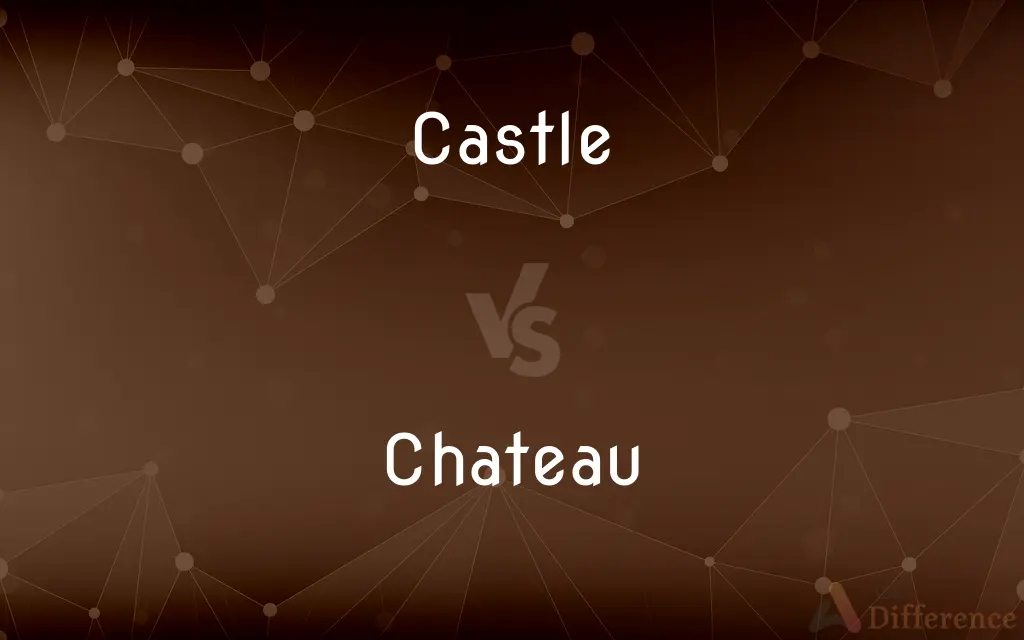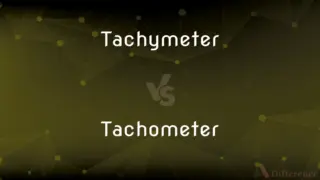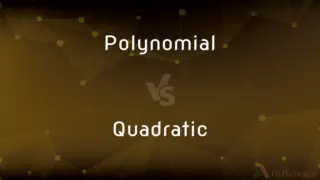Castle vs. Chateau — What's the Difference?
By Fiza Rafique & Urooj Arif — Updated on March 29, 2024
Castle is large fortified building or set of buildings with strong defensive capabilities, historically used for protection and military purposes. Château is grand houses or palaces in French-speaking regions, without defensive features and more luxury.

Difference Between Castle and Chateau
Table of Contents
ADVERTISEMENT
Key Differences
Castles were primarily built during the Middle Ages in Europe as fortified structures to protect against attacks. They served as military strongholds, residences for nobility or royalty, and centers of administration within a territory. On the other hand, châteaux are found predominantly in France and are known for their architectural beauty and historical significance as luxurious residences. Unlike castles, châteaux were not designed with defense as a primary concern but rather as symbols of wealth and power, often surrounded by vast lands and vineyards.
While the primary function of castles was defense, featuring thick walls, battlements, moats, and drawbridges, châteaux were designed for comfort and showcasing artistry, including elaborate gardens, ornate decorations, and expansive estates. The distinction also lies in their historical contexts; castles harken back to a time of frequent warfare and feudal systems, whereas châteaux emerged as expressions of the Renaissance and Enlightenment periods, reflecting shifts towards culture, art, and the consolidation of wealth without the immediate need for fortification.
In terms of architecture, castles blend functionality with fortification, often located in strategic positions such as hilltops or river bends to exploit natural defenses. Châteaux, however, prioritize aesthetic appeal and are exemplary of various architectural styles, from medieval fortresses to Renaissance palaces, depending on their era of construction. This architectural divergence underscores the evolution from martial necessity to an emphasis on luxury and societal status.
Despite their differences, both castles and châteaux are integral to their cultural landscapes, embodying the historical and architectural heritage of their regions. Today, many castles and châteaux have been preserved or repurposed as museums, hotels, or venues for events, allowing visitors to experience their grandeur and historical significance firsthand.
Comparison Chart
Primary Purpose
Defense and military stronghold.
Luxury residence and symbol of wealth.
ADVERTISEMENT
Architectural Style
Medieval, focused on fortification.
Varies, often Renaissance, emphasizing aesthetics.
Historical Period
Middle Ages, with an emphasis on feudal systems and warfare.
Renaissance and onwards, reflecting cultural shifts.
Defensive Features
Thick walls, moats, battlements, drawbridges.
Lacks traditional defensive features; focus on luxury.
Location
Often strategic, like hilltops or river bends.
Situated within expansive estates or vineyards.
Compare with Definitions
Castle
A fortified residence used in the Middle Ages.
The king ordered the construction of a new castle to defend the northern border.
Chateau
Grand country house or palace in France.
The château's vineyards produce some of the region's finest wines.
Castle
Large building with strong defensive structures.
The castle's thick walls have withstood many sieges over the centuries.
Chateau
Residence of nobility, without defensive purposes.
The château was known for its extravagant balls and gatherings.
Castle
Fortress with residential quarters.
The ancient castle overlooks the valley, offering a panoramic view.
Chateau
Architectural beauty, often surrounded by vast lands.
The sprawling gardens of the château attract visitors from around the world.
Castle
Symbol of military strength and protection.
The castle was a bastion against invaders during the medieval period.
Chateau
Luxurious estate with historical significance.
The château has been restored to its former glory, showcasing Renaissance architecture.
Castle
Medieval stronghold for nobility.
The castle served as the family seat for generations of nobles.
Chateau
Emblem of wealth and power in French-speaking regions.
Owning a château was a testament to one's social standing in the 18th century.
Castle
A castle is a type of fortified structure built during the Middle Ages predominantly by the nobility or royalty and by military orders. Scholars debate the scope of the word castle, but usually consider it to be the private fortified residence of a lord or noble.
Chateau
A large French country house or castle, often giving its name to wine made in its neighbourhood
Château Margaux
Castle
A large fortified building or group of buildings with thick walls, usually dominating the surrounding country.
Chateau
A castle or manor house in a French-speaking region.
Castle
A fortified stronghold converted to residential use.
Chateau
An estate where wine is produced and often bottled, especially in the Bordeaux region of France.
Castle
A large ornate building similar to or resembling a fortified stronghold.
Chateau
A large country house.
Castle
A place of privacy, security, or refuge.
Chateau
Alternative spelling of château
Castle
(Games) See rook2.
Chateau
A castle or a fortress in France.
Castle
To move the king in chess from its own square two empty squares to one side and then, in the same move, bring the rook from that side to the square immediately past the new position of the king.
Chateau
A manor house or residence of the lord of the manor; a gentleman's country seat; also, particularly, a royal residence; as, the chateau of the Louvre; the chateau of the Luxembourg.
Castle
To place in or as if in a castle.
Chateau
An impressive country house (or castle) in France
Castle
(Games) To move (the king in chess) by castling.
Castle
A large residential building or compound that is fortified and contains many defences; in previous ages often inhabited by a nobleman or king. Also, a house or mansion with some of the architectural features of medieval castles.
Castle
(chess) An instance of castling.
Castle
A rook; a chess piece shaped like a castle tower.
Castle
(shogi) A defense structure in shogi formed by defensive pieces surrounding the king.
Castle
(obsolete) A close helmet.
Castle
(dated) Any strong, imposing, and stately palace or mansion.
Castle
(dated) A small tower, as on a ship, or an elephant's back.
Castle
The wicket.
Castle
(transitive) To house or keep in a castle.
Castle
To protect or separate in a similar way.
Castle
(obsolete) To make into a castle: to build in the form of a castle or add (real or imitation) battlements to an existing building.
Castle
To move the king 2 squares right or left and, in the same turn, the nearest rook to the far side of the king. The move now has special rules: the king cannot be in, go through, or end in check; the squares between the king and rook must be vacant; and neither piece may have been moved before castling.
Castle
To create a similar defensive position in Japanese chess through several moves.
Castle
(cricket) To bowl a batsman with a full-length ball or yorker such that the stumps are knocked over.
Castle
A fortified residence, especially that of a prince or nobleman; a fortress.
The house of every one is to him castle and fortress, as well for his defense againts injury and violence, as for his repose.
Our castle's strengthWill laugh a siege to scorn.
Castle
Any strong, imposing, and stately mansion.
Castle
A small tower, as on a ship, or an elephant's back.
Castle
A piece, made to represent a castle, used in the game of chess; a rook.
Castle
To move the castle to the square next to king, and then the king around the castle to the square next beyond it, for the purpose of covering the king.
Castle
A large and stately mansion
Castle
A large building formerly occupied by a ruler and fortified against attack
Castle
(chess) the piece that can move any number of unoccupied squares in a direction parallel to the sides of the chessboard
Castle
Interchanging the positions of the king and a rook
Castle
Move the king two squares toward a rook and in the same move the rook to the square next past the king
Common Curiosities
Are all castles located on strategic defensive sites?
While many castles are strategically located for defense, not all were built with this consideration, especially those transformed for residential use in later periods.
How were châteaux funded historically?
Châteaux were often funded by the wealth of nobility or royalty, showcasing their power and status.
Was the primary purpose of a castle always military?
Primarily, yes, but over time, many castles transitioned to serve as noble residences, administrative centers, or even prisons.
What is the main difference between a castle and a château?
The main difference is their purpose; castles were built for defense, while châteaux were luxurious residences.
How do the architectural styles of castles and châteaux differ?
Castles focus on fortification features, while châteaux incorporate various styles, often highlighting artistry and comfort.
How important are castles and châteaux to history and culture?
They are crucial in understanding the social, political, and architectural history of their regions.
Can a château have defensive features?
Some châteaux might retain or mimic defensive features, but these are generally more aesthetic than functional.
Do châteaux only exist in France?
While châteaux are characteristic of French architecture, the term can be used for similar grand houses in other French-speaking regions.
Can a castle be considered a château?
In some contexts, particularly in France, large historic fortified residences might be referred to as châteaux, though they may have served defensive purposes.
Are there modern equivalents to castles or châteaux?
Modern equivalents might include luxury estates or highly secured residences, though they lack the historical and architectural significance.
Do castles and châteaux always belong to the state?
Ownership varies; some belong to the state, others to private individuals or organizations.
Is it possible to buy a castle or château?
Yes, some castles and châteaux are on the market, though they often require significant investment for maintenance and restoration.
What happens to old castles and châteaux today?
Many have been preserved as historical sites, museums, luxury hotels, or venues for events, contributing to cultural tourism.
What role do castles play in literature and film?
Castles often serve as iconic settings in stories, symbolizing fantasy, history, and adventure.
How do castles and châteaux contribute to tourism?
They attract visitors worldwide, offering a glimpse into the past and contributing to the local economy through tourism.
Share Your Discovery

Previous Comparison
Tachymeter vs. Tachometer
Next Comparison
Polynomial vs. QuadraticAuthor Spotlight
Written by
Fiza RafiqueFiza Rafique is a skilled content writer at AskDifference.com, where she meticulously refines and enhances written pieces. Drawing from her vast editorial expertise, Fiza ensures clarity, accuracy, and precision in every article. Passionate about language, she continually seeks to elevate the quality of content for readers worldwide.
Co-written by
Urooj ArifUrooj is a skilled content writer at Ask Difference, known for her exceptional ability to simplify complex topics into engaging and informative content. With a passion for research and a flair for clear, concise writing, she consistently delivers articles that resonate with our diverse audience.
















































